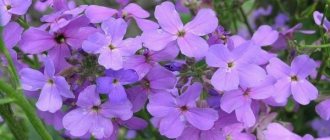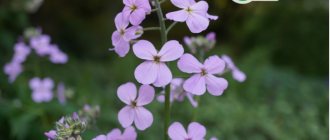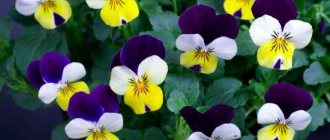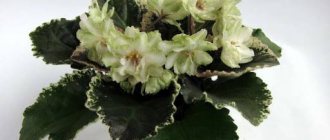The main value of the evening plant is its extraordinary aroma. This flower is known among gardeners under the name Hesperis, which means evening in Greek. The name was given to the plant in ancient times because its flowers fill the surrounding air with fragrance and intoxicating aroma in the evening and at night.
Other euphonious names of this unusual flower are known - Hesperis female, Hesperis matron. This plant has been cultivated since the 16th century, decorating the luxurious flowerbeds of landowners and nobles, creating a unique atmosphere in the landscape parks of Russian estates and country estates. Hesperis was Queen Marie Antoinette's favorite flower.
Hesperis is loved by many gardeners and is happily grown in flower beds and flower beds. Due to the numerous fragrant caps of inflorescences, matron's noctule is becoming a very popular plant.
What does a matron's party look like?
Hesperis is a herbaceous perennial of the Cruciferous family. Over 50 varieties grow naturally in Europe, Asia, Siberia and the Caucasus. The name of the flower, Hesperis, means “evening” to the Greeks. This is due to the fact that the incomparable aroma of the plant tends to intensify after sunset.
Hesperis flowering
Mainly varietal varieties of Hesperis matronalis are cultivated in gardens. The plant blooms in early summer on straight, branching shoots 0.5 - 1.2 m. The leaf of the noctule is elongated, serrated, the stem is strong, slightly pubescent.
The shape of the cylindrical inflorescence resembles another popular perennial - phlox. The difference is determined by the number of petals; cruciferous plants have four. The phlox flower has five petals.
Hesperis blooms with small (1.5-2 cm), depending on the variety, flat or double flowers. Nature's intended palette for the evening is represented by shades of white, pink, lilac and violet. By the end of summer, hesperis forms pods (5-6 cm) in which seeds ripen.
For reference: flower lovers read the Latin name of the matron's noctule differently: hesperis or hesperis. Even experienced florists do not undertake to confirm which name is correct.
Description and history
The stems of the night violet reach a height of 100-110 cm. They branch in the upper part. The tops of the green leaf blades are pointed. Large inflorescences resemble clusters. During the flowering period, the bushes look like lilacs. The flowers, arranged crosswise, are painted in a pale lilac palette. The plant's seeds ripen in pods after the flowering period ends. The seeds, colored brown, are quite small in size.
What does hesperis look like?
For your information! Flowers appeared in Europe in the mid-16th century. Queen of France Marie Antoinette loved to contemplate the blooming night violet bushes in her garden. 100 years later, the noctule was brought to the United States.
Description of varieties bred on the basis of Hesperis matronalis
Eveningweed is a plant that blooms in late spring, ahead of other garden flowers. Hesperis is usually planted in places where its enchanting scent can be enjoyed comfortably. It would be appropriate to place it along the paths, by the window or near the gazebo.
Night violet - what is it called and what does it look like?
Classification of the most decorative types:
- Hesperis Sibirica or Siberian noctule: a plant endemic to Siberia with a height of 0.3 - 1.30 m, shoots and foliage covered with stiff hairs, inflorescences mauve, milky white, flowering begins in mid-summer;
- Hesperis Tristis - sad or dark noctule: a compact bush 0.25 - 0.60 m, characterized by an unusual color of inflorescences - at the beginning of dissolution they are chocolate-purple, gradually changing color to pale yellow. Flowering is early, from late spring to mid-summer.
Note: The aroma is most intense after sunset and on cloudy days. During drought, the aroma noticeably weakens.
To create fragrant flower beds, the following varieties of Hesperis matronalis are used:
- Lilacina Flore Pleno - lilac-pink;
- Albiflora - lilac, terry variety;
- Nana Candidissima - a plant up to 50 cm high with white fragrant flowers;
- Purpurea Plena is a hesperis with double flowers of a purple hue.
- Malinovaya - large inflorescences of a juicy color, a tall bush with few leaves, used in the company of ornamental grasses;
- Рodmoskovnye vechera - tight elongated inflorescences are painted pale pink and white;
- Lirika large flowers of all colors typical of hesperis are collected in loose clusters.
Varieties with double flowers are suitable for cutting. They last in a vase for 10 - 12 days and all this time they delight with a charming aroma.
Inflorescence of the Evening Matrona
Types and varieties of noctule
Matron's noctule (Hesperis matronalis)
There are quite a few types of noctule, but only one is the most popular among gardeners - matron's noctule (Hesperis matronalis), or night violet. It comes from Asia Minor, the Mediterranean, Western Siberia and the Caucasus. This perennial plant is cultivated as a biennial. The height of the erect shoots is about 0.8 m; they are branched in the upper part. The sharp oval-lanceolate leaf blades have a slightly toothed edge; they can be bare or covered with white hair. Cylindrical racemose inflorescences consist of double or simple flowers, reaching about 20 mm in diameter; they can be white, pink, lilac or purple. Flowers begin to smell stronger in the evening and at night, and even in humid and cloudy weather. The most popular varieties are:
- nana candidissima - bush height is about half a meter, flowers are white and fragrant;
- purpurea plena - purple flowers are double.
Siberian noctule (Hesperis sibirica)
This Siberian endemic is becoming more and more popular every year. In nature, this species can be found in Dauria, Sayan Mountains, Altai, Lena, Irtysh and Yenisei. The height of such a biennial varies from 0.35 to 1.3 m. In the upper part, the stem branches, and there are glandular hairs on its surface. The upper leaf blades are narrow-lanceolate and sessile, and the lower ones are petiolate, oval-lanceolate, sharp with a serrated edge, and have pubescence on their surface. The flowers are white or mauve in color and have pubescent pedicels.
Gardeners also cultivate the yellow noctule species. However, it is usually grown as a medicinal plant.
Garden flowers that bloom at night. Mattiola - night violet
Growing from seeds
A two-year-old bush with ripe fruit-pods can simply be laid on the ground and covered with spruce branches or covering material. In the spring, under the shelter, you will find many seedlings ready for transplanting.
Hydrangea blue or blue - planting and care in open ground
From mid-spring, you can plant flowers of the nocturnal plant using the seedling method:
- The purchased seeds are sown in a shallow container, one-third filled with a drainage layer.
- A fertile layer is laid on top. If the soil for sowing is taken from the garden, it is recommended to water it in advance with potassium permanganate or foundationazole to avoid contamination of the seeds with fungal diseases or viruses.
- The seeds are distributed over the surface of the soil, not buried, only lightly sprinkled with substrate, then spilled with warm water and covered with film.
At a temperature of 18 - 20°C, the first shoots can hatch within three weeks.
Caring for seedlings consists of ventilating the seedlings and regularly moistening them. It is recommended not to water tender sprouts, but to spray them with a spray bottle. Loosen the soil around the roots with a match or toothpick.
With the appearance of 3 - 4 true leaves, young plants, if necessary, dive into separate containers, continuing to monitor the soil moisture.
Young violets are planted in a permanent place in late summer - early autumn, with a distance of 30 - 40 cm from each other.
Important! In the first year after planting, the seedlings form the rudiments of flower rosettes; full flowering occurs in late summer of the next year.
Although the plant is a perennial under natural conditions, it is cultivated for no longer than 2 years to obtain seed material. After 3 years, the quality of seeds for species propagation deteriorates.
Important! Night noctule needs aeration of the roots after watering; in the absence of loosening, young plants may die.
Caring for the noctule in the garden
Growing noctule in open soil is quite simple, like most other garden crops. Watering should be carried out regularly, and after it and after rain it is necessary to sometimes loosen the soil surface. After the appearance of weeds, they must be removed immediately, and the bushes must be systematically fed. In some cases, heavy inflorescences cause the stems to bend to the ground surface, making the bushes less attractive. In this case, you will need to install supports to which the shoots are tied.
Experts advise cutting off the inflorescences immediately after they wilt. This crop needs shelter only if a very frosty winter with little snow is expected. Plantings should be covered with non-woven material (lutrasil or spunbond). You can also use spruce paws to cover the area.
How to water and feed
Such flowers need to be watered on average once every 7 days; for this they use warm water heated in the sun. During prolonged dry and hot periods, the frequency of watering must be increased. At the same time, during prolonged rains, watering is suspended, since if the soil is excessively wet all the time, this significantly increases the likelihood that the bushes will be harmed by fleas, since they like to settle on crops belonging to the Brassica family. Watering and loosening the soil surface is necessary only in the morning.
During the first season, the flowers are regularly fed with a solution of complex mineral fertilizer, which contains a large amount of nitrogen. In the second year, during the period of bud formation, the plant should be fed with liquid complex fertilizer for beautifully flowering plants or phosphorus and potassium fertilizer.
Reproduction of the noctule
Species and varieties with simple flowers can be propagated by seed. But if double night violets are cultivated, then they are propagated exclusively by dividing the bush, since if you independently collect seeds from the bushes and sow them, then the grown plants will have simple flowers. The division of bushes of terry varieties is carried out at the beginning of the spring period or in the autumn. To do this, the bush is carefully removed from the ground, divided into several parts, and the cut areas are treated with crushed charcoal. Then the divisions are planted in holes that are prepared in advance.
In late autumn, before the first frost, the soil surface near the plants should be covered with a layer of mulch, which will protect the root system from severe frosts in winters with little snow.
Pests and diseases of noctule
Night violet is affected by the same diseases and harmful insects as other members of the Cruciferous family. Such a flower can be damaged by cabbage aphids, cruciferous flea beetles and bugs, stem stalker, cabbage moth, caterpillars of turnip and cabbage whites and cabbage cutworms, larvae of rapeseed sawfly and cabbage fly and cruciferous gall midge. Insecticides are used to kill harmful insects; they can be purchased at a specialty store. Experts advise trying to find a product that effectively destroys pests without harming the environment.
During the seedling period, seedlings may become infected with blackleg. More mature plants are sometimes affected by clubroot, downy mildew, Alternaria, sclerotinia, phomosis, botrytis and fusarium; these are also fungal diseases. Night violet can also be affected by bacterial diseases such as black rot and vascular bacteriosis. Viral diseases such as mosaic and ring spot are very dangerous for this crop, since today they are considered incurable. In the fight against fungal diseases, fungicides are highly effective, the choice of which in specialized stores is quite wide. However, those bushes that are affected by viral or bacterial diseases must be removed from the soil as soon as possible and destroyed. The area where the affected bushes were grown will not be suitable for growing any crop for three or four years.
However, if you follow the rules of prevention and provide the plants with proper care, they will be highly resistant to both harmful insects and diseases.
Features of home care
The plant is resilient and does not require care. It is better to plant noctule in well-lit places; in extreme cases, slight shading is possible. The soil needs to be slightly alkaline, structural, sand-lightened loam is optimal.
The flower is moisture-loving; in dry weather it is necessary to provide additional watering. Hesperis does not tolerate waterlogging and high groundwater levels. After watering, the root area must be loosened.
The plant has high winter hardiness, it can easily tolerate temperature changes and does not require shelter. In especially snowy winters, with a long melting of snow, the above-ground part can dry out.
Fertilizer
Before flowering, the noctule plant can be fed with complex fertilizer. She does not need regular feeding. If you add organic matter, it is important not to overdo it, so as not to end up with a riot of greenery without flowers.
The bushes branch well, so plantings of nocturnal plant are prone to thickening. To preserve the duration and decorativeness of flowering, faded inflorescences are cut off.
Important! The flower is not poisonous, but for those suffering from allergies it can cause unpleasant symptoms: itching, irritation of the skin and mucous membranes, allergic rhinitis.
Eveningwort flowers in a flowerbed
Description of night violet
Hesperis flower planting and care photo in the garden Hesperis matronalis
Hesperis belongs to the cruciferous family and resembles paniculate phlox in appearance. Distributed throughout the European part of Russia, found almost everywhere, from roadsides to forest edges, and the banks of reservoirs. It has a straight stem branched at the top, up to 80 cm long, covered with silky hair. The leaves are alternate, oval-lanceolate, attached to the stem with or without cuttings.
The small flowers are lilac in color, but in cultivation there are white and purple, single and double, they do not open at the same time - first the lower ones, then those closer to the top. Collected in loose, paniculate inflorescence. The plant is perennial, but is considered biennial - in the third year it usually falls out and grows from seed again. Flowering begins in the last ten days of May and lasts until August. After flowering, narrow, oblong pods with seeds are formed. To avoid self-sowing in the wrong place, you should pick off faded inflorescences.
Possible problems in growing
Hesperis is little susceptible to external factors.
It is believed that the plant may suffer from characteristic diseases of cruciferous crops. In fact, the noctule can be damaged in the lower part by slugs or cruciferous fleas. Both of them do not like ash; fleas do not tolerate moisture.
Important! If vegetables are grown on the site, then pests will probably prefer radishes and cabbage to nocturnal plants.
Like all garden plants, noctule can be affected by fungal and viral diseases. It is important to understand that diseases and pests appear if agricultural practices and preventive measures on the site are not followed.
It is believed that the noctule is a flower that is indispensable as a companion for lilies and roses. Its fragrant cloud of white, purple or pink will highlight their rich beauty and complement the home garden with a nightly aroma of scents. Beginning flower lovers can try planting this plant on their property to surprise their family and friends.
Pests and diseases of night violet
Hesperis belongs to the cabbage family and is affected by diseases and pests characteristic of them. Its lower leaves are gnawed by snails. Plants are attracted to cruciferous flea beetles, leaf miner butterflies, and aphids. It is easy to get rid of all these pests by watering the bushes with tar water at the root. Dilute 1 tbsp. spoon of birch tar in 10 liters of water, mix everything thoroughly. Insects cannot tolerate the smell of tar - preventative watering will ensure the complete absence of these insects on the noctule.
Night violet suffers from downy mildew in dense plantings, and is affected by cabbage clubroot and viral mosaic. Maintaining distance between plants is the key to healthy plantings. Clubroot is introduced along with seeds. It is worth disinfecting purchased seeds before sowing. If clubroot gets into your area, avoid re-seeding hesperis on the infected area for 5 years.











